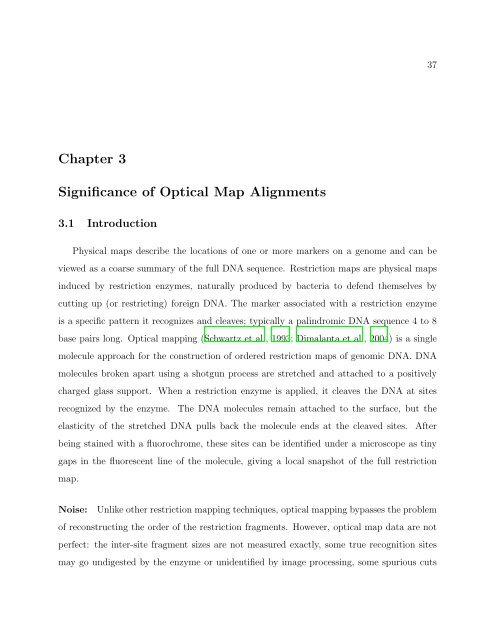On the Analysis of Optical Mapping Data - University of Wisconsin ...
On the Analysis of Optical Mapping Data - University of Wisconsin ...
On the Analysis of Optical Mapping Data - University of Wisconsin ...
You also want an ePaper? Increase the reach of your titles
YUMPU automatically turns print PDFs into web optimized ePapers that Google loves.
37<br />
Chapter 3<br />
Significance <strong>of</strong> <strong>Optical</strong> Map Alignments<br />
3.1 Introduction<br />
Physical maps describe <strong>the</strong> locations <strong>of</strong> one or more markers on a genome and can be<br />
viewed as a coarse summary <strong>of</strong> <strong>the</strong> full DNA sequence. Restriction maps are physical maps<br />
induced by restriction enzymes, naturally produced by bacteria to defend <strong>the</strong>mselves by<br />
cutting up (or restricting) foreign DNA. The marker associated with a restriction enzyme<br />
is a specific pattern it recognizes and cleaves; typically a palindromic DNA sequence 4 to 8<br />
base pairs long. <strong>Optical</strong> mapping (Schwartz et al., 1993; Dimalanta et al., 2004) is a single<br />
molecule approach for <strong>the</strong> construction <strong>of</strong> ordered restriction maps <strong>of</strong> genomic DNA. DNA<br />
molecules broken apart using a shotgun process are stretched and attached to a positively<br />
charged glass support. When a restriction enzyme is applied, it cleaves <strong>the</strong> DNA at sites<br />
recognized by <strong>the</strong> enzyme. The DNA molecules remain attached to <strong>the</strong> surface, but <strong>the</strong><br />
elasticity <strong>of</strong> <strong>the</strong> stretched DNA pulls back <strong>the</strong> molecule ends at <strong>the</strong> cleaved sites. After<br />
being stained with a fluorochrome, <strong>the</strong>se sites can be identified under a microscope as tiny<br />
gaps in <strong>the</strong> fluorescent line <strong>of</strong> <strong>the</strong> molecule, giving a local snapshot <strong>of</strong> <strong>the</strong> full restriction<br />
map.<br />
Noise: Unlike o<strong>the</strong>r restriction mapping techniques, optical mapping bypasses <strong>the</strong> problem<br />
<strong>of</strong> reconstructing <strong>the</strong> order <strong>of</strong> <strong>the</strong> restriction fragments. However, optical map data are not<br />
perfect: <strong>the</strong> inter-site fragment sizes are not measured exactly, some true recognition sites<br />
may go undigested by <strong>the</strong> enzyme or unidentified by image processing, some spurious cuts
















